| HOME |
| Hotels |
| Apartments |
| Attractions |
| Restaurants |
| Tickets & tours shop |
| Tours |
| Maps & travel planners |
| Airports & transport |
| Maps |
| Events |
| Shopping |
| Contact us |
|
| Barcino. Pictures Roman city Barcelona - Roman walls |
Barcelona Roman walls and remainsUpdated January 2025Pictures of Roman walls and remains of the Roman city of Barcelona called Barcino. Barcelona was founded by the Romans in 14 A.D. Map Barcelona Roman walls. Barcino 3D from Barcelona Cultura on Vimeo. Barcino is the ancient Roman name for the city of Barcelona, Spain. It was founded by the Roman Empire in the 1st century BC and served as an important port and trading center for the Roman empire. Fragments of the Roman walls and Roman ruins of Barcino are still visible in modern day Barcelona.. The full Roman name for Barcelona in Roman times was Colonia Iulia Augusta Faventia Paterna Barcino. Barcelona does not have a Roman festival, but there are Roman festivals near Barcelona. Barcelona's close neighbouring city Badalona organises a Roman festival called Magna Celebratio and 1 hour to the south of Barcelona is Tarragona which was called Tarraco in Roman times. Tarraco was the biggest Roman city in ancient times outside Italy and has very impressive Roman ruins, which you can see on a day tour to Tarragona. Tarraco organises an annual Roman festival called Tarraco Viva. Below: an artists impression of Roman city of Barcino with Montjuic hill is in the background. Fragments of the Roman walls are still in use in Barcelona's gothic quarter. 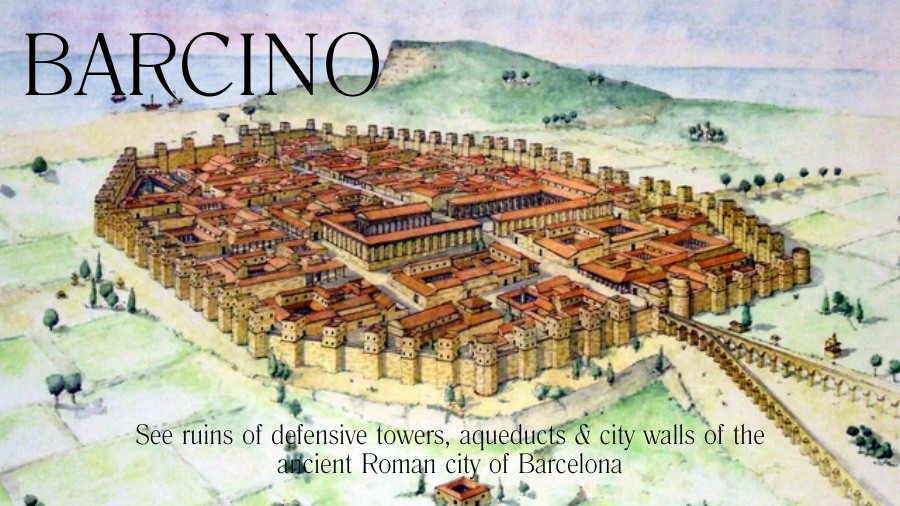 Artist's impression of the Roman city of Barcelona. 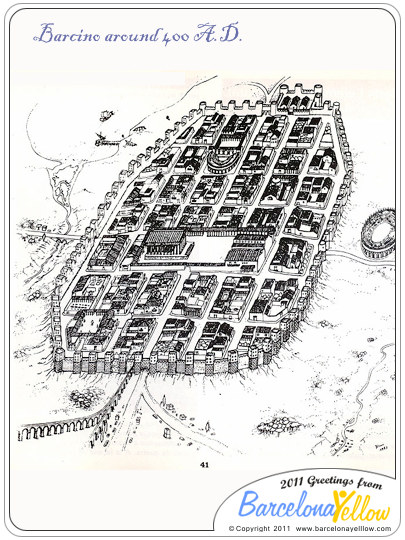 Map location of Roman walls of Barcino in relation to present map of Barcelona. Map Roman walls Barcelona 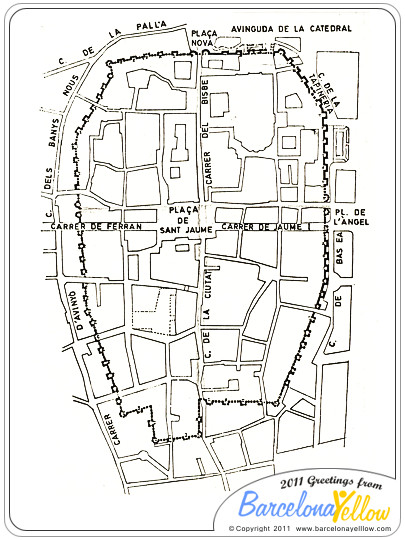 Below: Layout of priginal Barcino Roman town founded in 14 A.D. 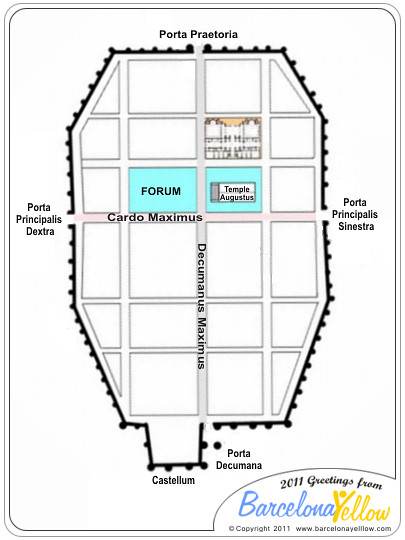 Below: Plaça Nova. Well-preserved sections of 3.5 m thich Roman walls and towers. The entire perimeter of the Roman walls of Barcina was 1270 metres. On Plaça Nova you can see two square towers from the second Roman city wall city dating from the fourth century AD. In the fifteenth century the "Casa de l’Ardiaca" the Archdeacon's house (in the left of the picture) was built on top of these walls. This building now houses Barcelona's historical archives in Arxiu Històric de la Ciutat de Barcelona.The Roman name of the gate on Plaça Nova was called Porta Praetoria, which led into the street Decumanus Maximus. Later it was named the Bishop's Gate. 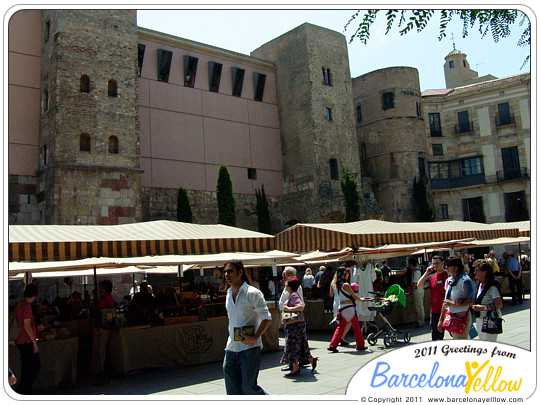 Below: Plaça Nova Roman aqueduct by the Porta Praetoria. The current arch of the aqueduct is a reconstrucion which was made to show where the Roman aqueduct entered Barcino. If you want to see an original part of a Roman aqueduct, then head for Tarragona, which has impressive Roman ruins including an amphitheatre, chariot racing track and aqueduct. Day tours to Tarragona 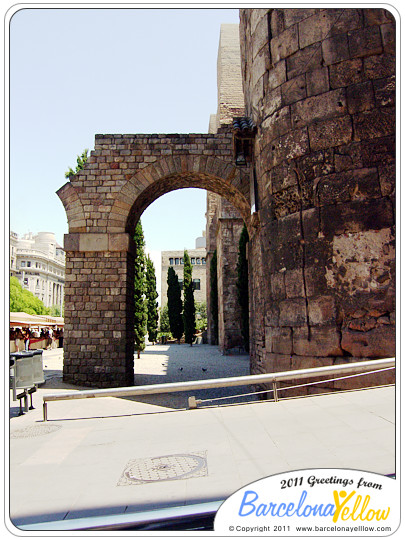 Below: Carrer de Duran i Bas. Several arches of one of the two original Roman aqueducts which brought fresh water into Roman town of Barcelona 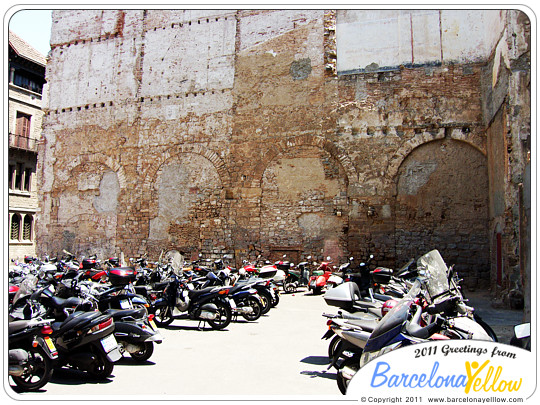 Below: Plaça Vila de Madrid. Vía Sepulcral - Roman necropolis. This was the burial site of the Roman city of Barcino. There are seventy tombs visible dating from the second and third centuries AD. The Roman cemetery of Barcino was outside the Barcino city wall along the Roman road called Vía Sepulcral. This is now inside the city center and some of the tombs have been excavated and restored. 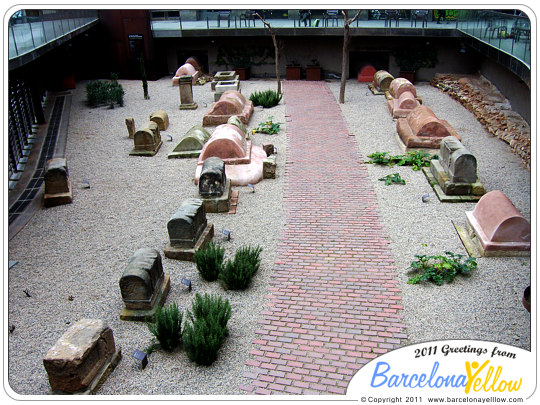 Roman tomb on Plaça Vila de Madrid in Barcelona 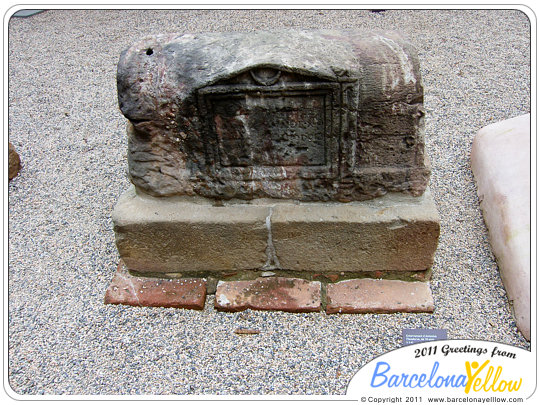 Baixada del Caçador. Remains of first Roman wall and tower from second Roman wall 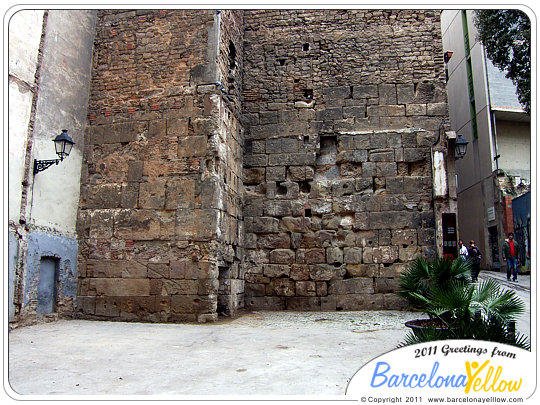 Day Tour Tarragona near Barcelona 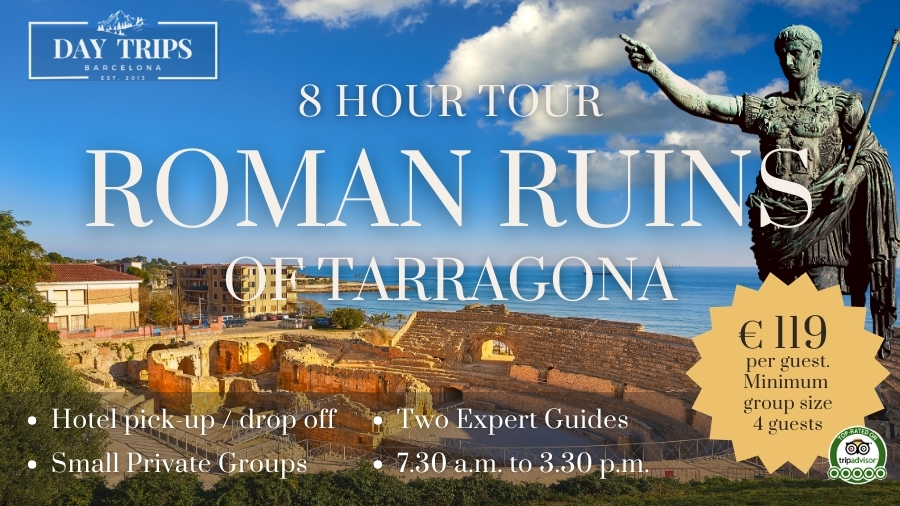 Below: Carrer del Regomir, 3 - Pati Llimona. Part of inside of Roman walls from first century AD which was used to build the March family palace in the 14th century. These wall remains can be seen inside the Pati Llimona civic centre in Carrer del Regomir. The small gate was for pedestrians to enter the city. 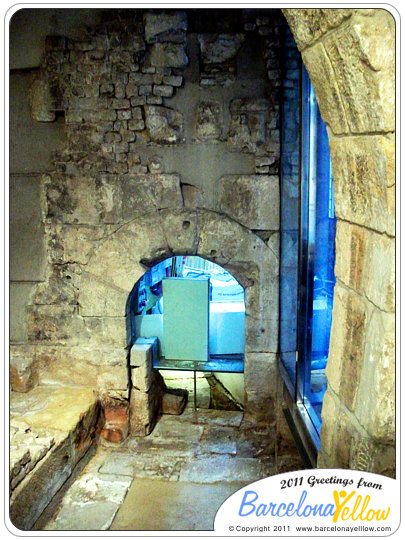 Plaça de Ramon Berenguer on Via Laietana. Roman walls and towers, which became part of the Capella Reial de Santa Àgata and Palau Reial Major. 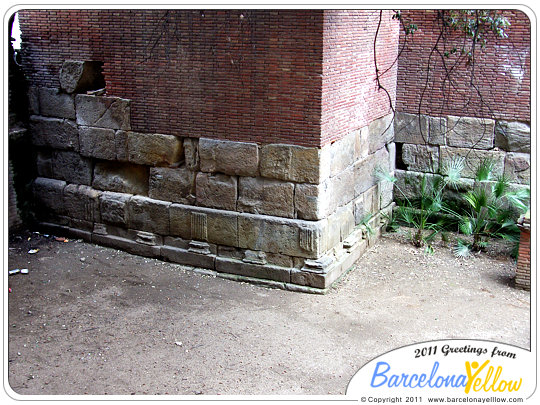 Barcelona Roman remains on Plaça de Ramon Berenguer by the street Via Laietana. This section of the Roman wall from the 4th century A.D. became part of Capella Reial de Santa Àgata i el Palau Reial Major (Royal Chapel of Santa Àgata and the Royal Palace) which was built in the 14th century. 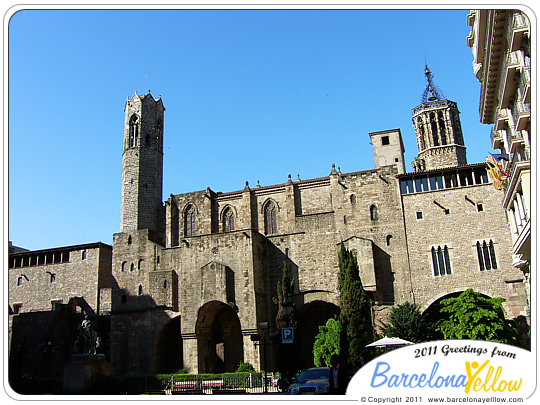 Below: Barcelona Roman wall remains on Plaça de Ramon Berenguer by Via Laietana 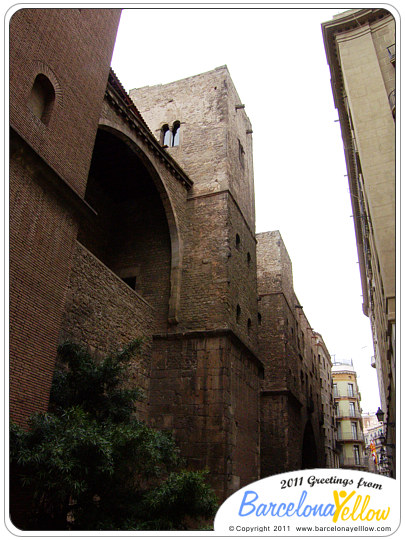 Roman wall in Barcelona on Plaça de Ramon Berenguer by street Via Laietana 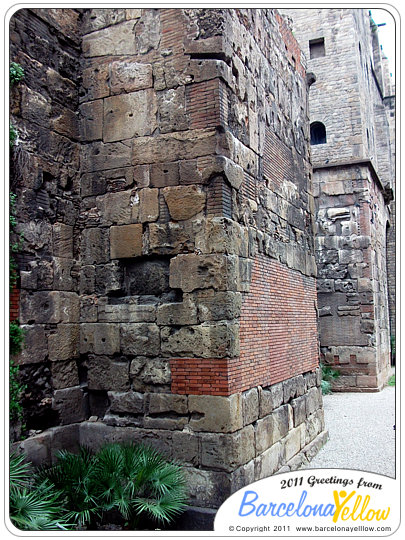 Carrer del Paradís 10-12. Four remaining columns of the Temple of Augustus which was located on Barcino's Roman Forum. These 9m high columns are actually inside the premises of "Centre Excursionista de Catalunya." The Temple of Augustus was built in the first century BC and was dedicated to Emperor Augustus. It was a hexastyle temple with 6 columns in front. The dimensions were 37 metres in length and 17 metres in width. Outside Carrer de Paradis 10 in Barcelona's gothic area, you can see a millstone that marks the location of Mont Tàber, which was the highest point of the Roman city of Barcino. Mont Tàber was a hillock just over 16 metres high. 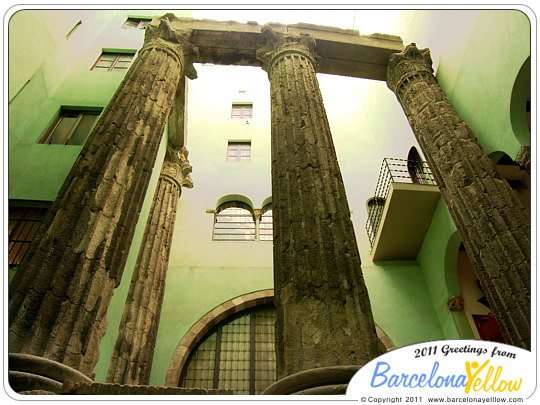 Artists impression of what the Temple of Augustus in Barcino looked like. The temple of the Roman colony of Barcino was in the Roman forum, which was the public square where all the important public buildings of Barcino were built. In modern day Barcelona this location is still where the government of Catalunya and Barcelona is situated 2000 years later. Other public buildings in Barcelona's Roman forum were the templte and the Curia, where the Ordo Decurionum (municipal senate) would meet. 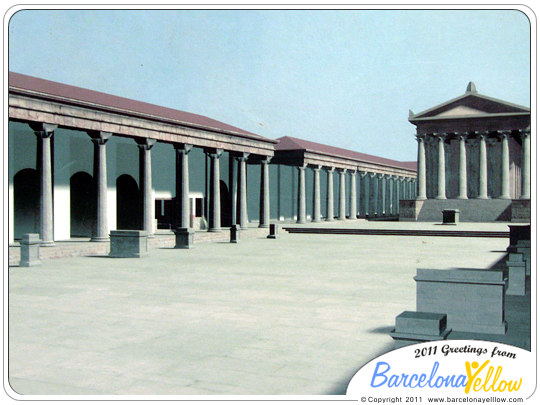 Plaça Traginers. Round Roman tower that was part of second Barcelona Roman wall built in 4th century A.D. 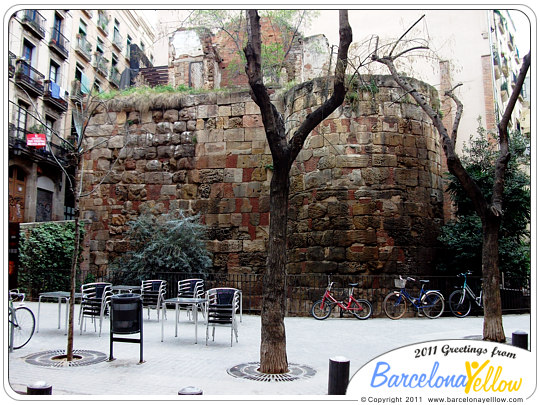 Map Roman walls Barcelona More pictures Barcelona This page sponsored by:  DayTripsBarcelona © Copyright Barcelonayellow.com All rights reserved. Do not copy text or images on this page without permission |
| Last Updated on Sunday, 12 January 2025 16:33 |
|
|
Friday, 15 August 2025

Barcelona Spain - Barcelona Travel Guide - Copyright 2007-2025
Privacy Policy and Cookies • Legal Disclaimer • Copyright
BarcelonaYellow SiteMap 2025
Barcelona Latest News:
COVID-19 - Barcelona Latest News
Barcelona Safety Guide 2025
Barcelona Top 10 attractions 20254
Plan 3 days in Barcelona 2025
About us
About us
Contact us
Privacy Policy and Cookies
Copyright notice
Legal disclaimer
Twitter Barcelona events
Partnerships
Advertising
COVID-19 - Barcelona Latest News
Barcelona Safety Guide 2025
Barcelona Top 10 attractions 20254
Plan 3 days in Barcelona 2025
About us
About us
Contact us
Privacy Policy and Cookies
Copyright notice
Legal disclaimer
Twitter Barcelona events
Partnerships
Advertising
Accommodation
Hotels in Barcelona
Hotels near Fira Exhibition
Hotels near Camp Nou
Hotels near Cruise Ships
Short Stay Apartments
Practical information
Useful visitor information
How to get to Barcelona airport
Cruise Ship Terminals
Barcelona maps
Airport buses
Barcelona metro
Taxis
Travel cards
Hotels in Barcelona
Hotels near Fira Exhibition
Hotels near Camp Nou
Hotels near Cruise Ships
Short Stay Apartments
Practical information
Useful visitor information
How to get to Barcelona airport
Cruise Ship Terminals
Barcelona maps
Airport buses
Barcelona metro
Taxis
Travel cards
Things to do
Top 10 attractions Barcelona
Photos of Barcelona
Restaurant Guide
Nightlife Guide
Things to do in Barcelona
Barcelona beaches
Book tours and tickets
Skiing near Barcelona
Weather Barcelona
Weather in Barcelona
5 day forecast Barcelona
Top 10 attractions Barcelona
Photos of Barcelona
Restaurant Guide
Nightlife Guide
Things to do in Barcelona
Barcelona beaches
Book tours and tickets
Skiing near Barcelona
Weather Barcelona
Weather in Barcelona
5 day forecast Barcelona
Top Festivals and events
Barcelona Events 2025
Christmas in Barcelona
New Years Eve 2025
MWC 2025 Barcelona
Sant Jordi's Day
Barcelona Marathon
Barcelona Half Marathon
Easter
Festa de Gracia
La Merce Festival
FC Barcelona calendar
Barcelona Events 2025
Christmas in Barcelona
New Years Eve 2025
MWC 2025 Barcelona
Sant Jordi's Day
Barcelona Marathon
Barcelona Half Marathon
Easter
Festa de Gracia
La Merce Festival
FC Barcelona calendar
Moving to Barcelona
Moving to Barcelona
Long term apartment rentals
Relocation agencies
Real estate agencies
Spanish schools
Meeting people
Finding work
Yellow pages directory
Partner websites:
DayTripsBarcelona.com
Stepbac.com
PhotoMemoirs.co
Helpfurl.com
Moving to Barcelona
Long term apartment rentals
Relocation agencies
Real estate agencies
Spanish schools
Meeting people
Finding work
Yellow pages directory
Partner websites:
DayTripsBarcelona.com
Stepbac.com
PhotoMemoirs.co
Helpfurl.com
